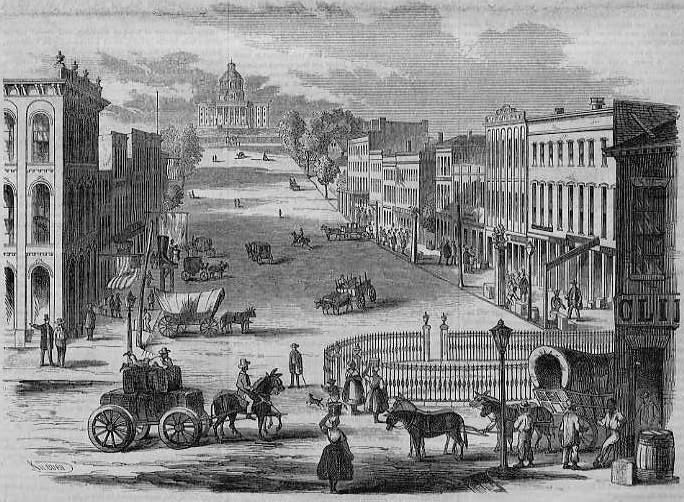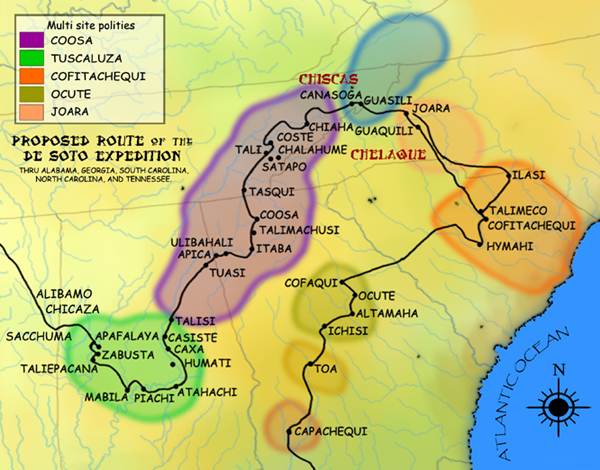|
Sylacauga, Alabama
Sylacauga is a city in Talladega County, Alabama, United States. At the 2020 census, the population was 12,578. Sylacauga is known for its fine white marble bedrock. This was discovered shortly after settlers moved into the area and has been quarried ever since. The marble industry was the first recorded industry in the Sylacauga area. Sylacauga is the site of the first documented case of an object from outer space hitting a person. On November 30, 1954, a piece of what became known as the Hodges Fragment from the Sylacauga Meteorite crashed through the roof of an Oak Grove house, bounced off a radio, and badly bruised Ann Hodges, who was taking an afternoon nap. Sylacauga is on the 2010 list of "100 Best Communities for Young People" by America's Promise Alliance. History The first historical account of the area comes from de Soto's chroniclers as his expedition traveled south along the east bank of the Coosa River in 1540, encountering the town of Talisi at the edge ... [...More Info...] [...Related Items...] OR: [Wikipedia] [Google] [Baidu] |
City
A city is a human settlement of notable size.Goodall, B. (1987) ''The Penguin Dictionary of Human Geography''. London: Penguin.Kuper, A. and Kuper, J., eds (1996) ''The Social Science Encyclopedia''. 2nd edition. London: Routledge. It can be defined as a permanent and densely settled place with administratively defined boundaries whose members work primarily on non-agricultural tasks. Cities generally have extensive systems for housing, transportation, sanitation, utilities, land use, production of goods, and communication. Their density facilitates interaction between people, government organisations and businesses, sometimes benefiting different parties in the process, such as improving efficiency of goods and service distribution. Historically, city-dwellers have been a small proportion of humanity overall, but following two centuries of unprecedented and rapid urbanization, more than half of the world population now lives in cities, which has had profound consequences for g ... [...More Info...] [...Related Items...] OR: [Wikipedia] [Google] [Baidu] |
America's Promise Alliance
America's Promise Alliance is the nation’s largest cross-sector alliance of nonprofit, community organizations, businesses, and government organization dedicated to improving the lives of young people. The organization was founded on the idea that children and youth need “Five Promises” to thrive—caring adults, safe spaces, a healthy start, effective education, and the opportunity to serve—but that not nearly enough young people have access to these basic resources. America’s Promise works to raise awareness about the importance of these resources and inspire actions that help more children and youth receive them. The organization does this by leading national public awareness campaigns, conducting research, hosting events and convening summits, and partnering with hundreds of national, state, and community organizations that work directly with youth. America’s Promise is currently chaired by Alma Powell and was formerly led by her husband and founding chairman, re ... [...More Info...] [...Related Items...] OR: [Wikipedia] [Google] [Baidu] |
Winterboro, Alabama
Winterboro, also spelled Winterborough, is an unincorporated community in Talladega County, Alabama, United States. History The state of Alabama incorporated the Central Plank Road on January 30, 1850. It was planned to run from Montgomery to Guntersville via Talladega. Joseph Winter planned the road, but the people of Talladega did not give him their expected financial support. As a consequence, Winter ended the plank road at Winterboro and named the settlement for himself. A post office called Winterboro was established in 1853 and remained in operation until 1875. During the Great Depression, the Civilian Conservation Corps cleared brush from pastures around Winterboro. Today, Winterboro is at the junction of Alabama State Route 21 and Alabama State Route 76. One structure in Winterboro, the Winterboro Stagecoach Inn, is listed on the National Register of Historic Places. Geography Winterboro is located in the east central part of the state at 33° 19′ 17″ N, 86° 11� ... [...More Info...] [...Related Items...] OR: [Wikipedia] [Google] [Baidu] |
Montgomery, Alabama
Montgomery is the capital city of the U.S. state of Alabama and the county seat of Montgomery County. Named for the Irish soldier Richard Montgomery, it stands beside the Alabama River, on the coastal Plain of the Gulf of Mexico. In the 2020 census, Montgomery's population was 200,603. It is the second most populous city in Alabama, after Huntsville, and is the 119th most populous in the United States. The Montgomery Metropolitan Statistical Area's population in 2020 was 386,047; it is the fourth largest in the state and 142nd among United States metropolitan areas. The city was incorporated in 1819 as a merger of two towns situated along the Alabama River. It became the state capital in 1846, representing the shift of power to the south-central area of Alabama with the growth of cotton as a commodity crop of the Black Belt and the rise of Mobile as a mercantile port on the Gulf Coast. In February 1861, Montgomery was chosen the first capital of the Confederate States of ... [...More Info...] [...Related Items...] OR: [Wikipedia] [Google] [Baidu] |
Plank Road
A plank road is a road composed of wooden planks or puncheon logs. Plank roads were commonly found in the Canadian province of Ontario as well as the Northeast and Midwest of the United States in the first half of the 19th century. They were often built by turnpike companies. Origins The Wittmoor bog trackway is the name given to each of two historic plank roads or boardwalks, trackway No. I being discovered in 1898 and trackway No. II in 1904 in the ''Wittmoor'' bog in northern Hamburg, Germany. The trackways date to the 4th and 7th century AD, both linked the eastern and western shores of the formerly inaccessible, swampy bog. A part of the older trackway No. II dating to the period of the Roman Empire is on display at the permanent exhibition of the Archaeological Museum Hamburg in Harburg, Hamburg. This type of plank road is known to have been used as early as 4,000 BC with, for example, the Post Track found in the Somerset levels near Glastonbury, England. This type of ... [...More Info...] [...Related Items...] OR: [Wikipedia] [Google] [Baidu] |
Indian Removal Act
The Indian Removal Act was signed into law on May 28, 1830, by United States President Andrew Jackson. The law, as described by Congress, provided "for an exchange of lands with the Indians residing in any of the states or territories, and for their removal west of the river Mississippi." During the Presidency of Jackson (1829-1837) and his successor Martin Van Buren (1837-1841) more than 60,000 Indians from at least 18 tribes were forced to move west of the Mississippi River where they were allocated new lands. The southern tribes were resettled mostly in Indian Territory (Oklahoma). The northern tribes were resettled initially in Kansas. With a few exceptions the United States east of the Mississippi and south of the Great Lakes was emptied of its Indian population. The movement westward of the Indian tribes was characterized by a large number of deaths occasioned by the hardships of the journey. Also available in reprint from thHistory News Network The U.S. Congress approve ... [...More Info...] [...Related Items...] OR: [Wikipedia] [Google] [Baidu] |
Peter Chartier
Peter Chartier (16901759) (Anglicized version of Pierre Chartier, sometimes written Chartiere, Chartiers, Shartee or Shortive) was a fur trader of mixed Shawnee and French parentage. Multilingual, he later became a leader and a band chief among the Pekowi Shawnee. As an early advocate for Native American civil rights, he joined other chiefs in opposing the sale and trade of alcohol in indigenous communities in the Province of Pennsylvania. He first tried to limit the sale of rum in Shawnee communities but expanded that effort to other indigenous peoples. Because of conflict with the English provincial government, in 1745 he accepted a French commission and left Pennsylvania with his band. Beginning with more than 400 Pekowi Shawnee, he migrated over the next four years through parts of modern Ohio, Kentucky, Alabama and Tennessee. He and his people eventually resettled in Illinois Country, near a French colonial community. He and some of his warriors later fought on the side of ... [...More Info...] [...Related Items...] OR: [Wikipedia] [Google] [Baidu] |
Shawnee
The Shawnee are an Algonquian-speaking indigenous people of the Northeastern Woodlands. In the 17th century they lived in Pennsylvania, and in the 18th century they were in Pennsylvania, Ohio, Indiana and Illinois, with some bands in Kentucky and Alabama. By the 19th century, they were forcibly removed to Missouri, Kansas, Texas, and ultimately Indian Territory, which became Oklahoma under the 1830 Indian Removal Act. Today, Shawnee people are enrolled in three federally recognized tribes, all headquartered in Oklahoma: the Absentee-Shawnee Tribe of Indians, Eastern Shawnee Tribe of Oklahoma, and Shawnee Tribe. Etymology Shawnee has also been written as Shaawanwaki, Ša·wano·ki, Shaawanowi lenaweeki, and Shawano. Algonquian languages have words similar to the archaic ''shawano'' (now: ''shaawanwa'') meaning "south". However, the stem ''šawa-'' does not mean "south" in Shawnee, but "moderate, warm (of weather)": See Charles F. Voegelin, "šawa (plus -ni, -te) MODERATE, WARM ... [...More Info...] [...Related Items...] OR: [Wikipedia] [Google] [Baidu] |
Muscogee People
The Muscogee, also known as the Mvskoke, Muscogee Creek, and the Muscogee Creek Confederacy ( in the Muscogee language), are a group of related indigenous peoples of the Southeastern Woodlands, indigenous (Native American) peoples of the Southeastern WoodlandsTranscribed documents Sequoyah Research Center and the American Native Press Archives in the United States, United States of America. Their original homelands are in what now comprises southern Tennessee, much of Alabama, western Georgia (U.S. state), Georgia and parts of northern Florida. Most of the Muscogee people were forcibly Indian Removal, removed to Indian Territory (now Oklahoma) by the federal government in the 1830s during the Trail of Tears. A small group of the Muscogee Creek Confederacy remained in Alabama, and t ... [...More Info...] [...Related Items...] OR: [Wikipedia] [Google] [Baidu] |
Tuskaloosa
Tuskaloosa (''Tuskalusa'', ''Tastaluca'', ''Tuskaluza'') (died 1540) was a paramount chief of a Mississippian chiefdom in what is now the U.S. state of Alabama. His people were possibly ancestors to the several southern Native American confederacies (the Choctaw and Creek peoples) who later emerged in the region. The modern city of Tuscaloosa, Alabama, is named for him. Tuskaloosa is notable for leading the Battle of Mabila at his fortified village against the Spanish conquistador Hernando de Soto. After being taken hostage by the Spanish as they passed through his territory, Tuskaloosa organized a surprise attack on his captors at Mabila, but was ultimately defeated. Contemporary records describe the paramount chief as being very tall and well built, with some of the chroniclers saying Tuaskaloosa stood a foot and a half taller than the Spaniards. His name, derived from the western Muskogean language elements ''tashka'' and ''losa'', means "Black Warrior". De Soto expedit ... [...More Info...] [...Related Items...] OR: [Wikipedia] [Google] [Baidu] |
Coosa Chiefdom
The Coosa chiefdom was a powerful Native American paramount chiefdom in what are now Gordon and Murray counties in Georgia, in the United States."Late Prehistoric/Early Historic Chiefdoms (ca. A.D. 1300-1850)" ''''. Retrieved July 22, 2010. It was inhabited from about 1400 until about 1600, and dominated several smaller chiefdoms. The total population of Coosa's area of influence, reaching into present-day Tennessee and Alabama, has been estimated at 50,000. |
Mississippian Culture
The Mississippian culture was a Native Americans in the United States, Native American civilization that flourished in what is now the Midwestern United States, Midwestern, Eastern United States, Eastern, and Southeastern United States from approximately 800 CE to 1600 CE, varying regionally. It was known for building large, earthen platform mounds, and often other shaped mounds as well. It was composed of a series of urban settlements and satellite villages linked together by loose trading networks. The largest city was Cahokia, believed to be a major religious center located in what is present-day southern Illinois. The Mississippian way of life began to develop in the Mississippi River Valley (for which it is named). Cultures in the tributary Tennessee River Valley may have also begun to develop Mississippian characteristics at this point. Almost all dated Mississippian sites predate 1539–1540 (when Hernando de Soto explored the area), with notable exceptions being Natchez p ... [...More Info...] [...Related Items...] OR: [Wikipedia] [Google] [Baidu] |





.jpg)




